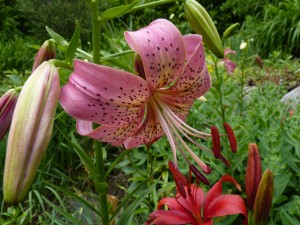Lughnasa Waxing Artemis Moon
Up early and out in the garden. This is the way I like it, working in the garden before and during sunrise, a coolness, some damp lingering from the night, stillness carrying only the softest of sounds, the earth friable and eager, weeds willing to come up and the garden’s purpose easy to discern.
Kate worked on in the orchard, going back over intensive weeding of a week ago and pulling up sprouts and rhizomes, making the place just that more inhospitable for the weedy plants. With a second load of mulch we’ll have this place looking ship-shape heading into fall.
A few grasses have begun to turn brown and there’s a slight hint of autumn in the morning air, a certain clarity and crispness.
After inspecting the garden again yesterday, I’m moving my grade from a B- to a B+. Why? I did three plantings of beets, greens, carrots and beans. Now the second planting has come to maturity after many other plants finished their summer and gave up their yield. We have a good crop of young beets, a lot of juicy carrots, plenty of greens and enough beans for a couple more freezer bags at least. This planting weekly or so for a while, creates a series of gardens, all in the same place. We even have a number of Cherokee Purple tomato plants which I did not plant. They are volunteers from last year’s tomatoes.
Add to these the onions, garlic, greens, beans, beets and various fruits already harvested we have a good gardening year, not a great one, but a good one.
Plus those potatoes are still in the ground, the raspberries have begun to fruit and the fennel and leeks look good. All in all, not bad. I said at the beginning of the growing season that I saw this as a consolidation year, a year when we make sure we can care for what we have. A week ago I would have said we hadn’t even met that mark, but now I believe we have. Caring for the orchard, the vegetable garden and the new plantings from last year in there, managing the bees and getting ready for the honey harvest, plus pruning out and restoration in the perennial flower beds.
This advance is mostly thanks to Kate’s back surgery and her hip surgery. She can now care for the garden, too, as she has in the past and it requires the both of us, what we have now. Getting back to normal speed.

 weeks ahead, at least that stuff that I got in the ground at temperature, but not date, appropriate times. I know, this is weather and that’s climate, still, one measure of the advance of global warming is earlier springs, which bring earlier plant blooming cycles. Of course, one year is not a trend.
weeks ahead, at least that stuff that I got in the ground at temperature, but not date, appropriate times. I know, this is weather and that’s climate, still, one measure of the advance of global warming is earlier springs, which bring earlier plant blooming cycles. Of course, one year is not a trend.